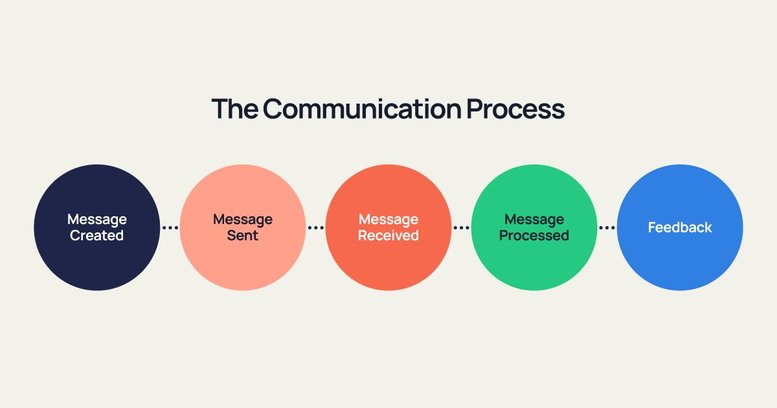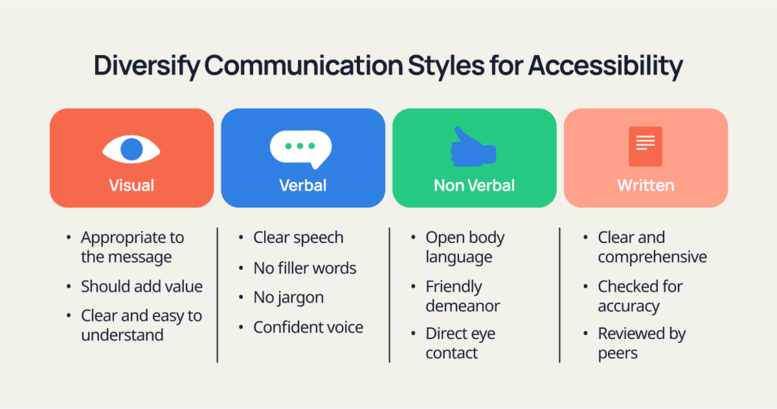
How to Avoid a Communication Breakdown at Work
Top strategies to help keep communication channels open
October 10, 2023
Good communication is a two-way street, where you meet each other halfway. If either party doesn’t hold up their end, it can lead to a communication breakdown. This becomes especially inconvenient if it’s happening at work, where miscommunication can cause delays, waste of resources, and discord within the team.
This blog will cover the most common causes of communication breakdown and what you can do to rectify them.
The Communication Process
- The communication process begins with formulating a message. The audience and purpose of the message have a bearing on the way it is expressed.
- The next step is sending the message, where it eventually makes its way to the recipient.
- The received information is interpreted and processed.
- The last step is feedback, which may just mean active listening on their part.
This process doesn’t guarantee effective communication, but without going through these steps, communication is incomplete.

Types of Communication
Communication is a broad term that encompasses all types of transfer of information. We can simplify things by breaking the term down into four specific types that we use every day.
Verbal
This is the type of communication where we use speech to relay information to a person or group of people. This is usually the most common type of communication, used for in-person or virtual meetings, presentations, or phone calls.
Some factors that demonstrate good verbal communication include using a strong, confident voice, clear speech, and proper enunciation.
Avoid using filler words as much as possible. Employ active listening skills to see how your audience is responding to your message. Not everyone is going to be vocal if they disagree or fail to grasp something, so you also have to be adept at picking up on non-verbal cues.
Verbal communication also includes sign language, which should be a part of your practice for accessibility purposes.
Non-verbal
Non-verbal communication includes body language, gestures, and facial expressions that other people can use to interpret information you have not put into words. This type of communication is much harder to control, and unless you are acutely self-aware, you could unintentionally give the wrong impression.
Open body language, direct eye contact, and an overall friendly demeanor give your message added authenticity.
Visual
Visual communication is the use of aids such as photographs, art, sketches, graphs, or charts to relay information. These can be a way to reinforce your message or make it easily decipherable at a glance. Information that would take several paragraphs to write or say can be shown visually in one image.
Visual communication should be appropriate to the message and audience. It should enhance and add value to the message and should be clear and easy to understand.
Written
A written message can accompany other forms of communication. An example of the written and verbal forms together could be a presentation where the presenter has a PowerPoint running in the background to reinforce the salient points.
Books, flyers, pamphlets, posters, and blogs often have visuals that break up monotony in written text and help to retain the reader’s interest.
In the workplace, written communication can take the form of documents such as memos, proposals, briefs, or company policies. It’s important to ensure that the tone is appropriate to the purpose of the written information.
Keep your writing professional, comprehensive, and clear.
Check your data for factual accuracy. Peer reviews should be mandatory, because another set of eyes may see errors you miss.
As hybrid and remote work models gain popularity around the world, written, asynchronous communication is becoming a crucial part of everyone’s workday. Swit’s platform gives you access to contextual communication, trackable project management, and cross-workspace shareability, for an agile and seamless workflow. With Swit’s pricing plans, you have the option to customize and pay for only what you need.

How to Identify a Communication Breakdown
Some examples of a communication breakdown would be:
- A new employee makes a time-consuming mistake due to a lack of proper training during onboarding
- Two members of a team work on the same task without realizing
- Important deadlines are missed when team members don’t regularly update each other.
- Working on a task with a quick turnaround time may cause a distracted manager to provide incomplete instructions for another task.
- False rumors spread about an important project because a junior member misunderstood the manager
For all these problems, Swit is the obvious solution.
You have the option to set the priority on a task card to let your team know what needs to be tackled first. Task cards can be assigned to specific team members, and on a more granular level, even checklist items can be assigned so that there is never any confusion about responsibility. With important information written out and shared through channels, everyone has access to clear instructions, and rumors are kept at bay.
How to Handle a Communication Breakdown
Clear and intentional communication
One of the best ways to handle a communication breakdown is to set rules for particular types of information. News that needs to be shared with the entire organization should have a different communication channel than information meant only for an individual employee. Similarly, departments, teams, project-specific groups, and one-on-one communication all require distinctive paths.
Swit Channels can be as specific as needed and can be set to be either public to the entire workspace or private for a select audience.
You can have an HR channel to share information related to company policies, or a Sales channel, where targets for the quarter are shared. You can tag teams, groups, channels, or individuals in your message to ensure it’s seen by the person or people you intend.
For all-hands meetings, important presentations, and one-on-one chats, integrations such as Google Workspace and MS 365 are ideal. You can also share files, emails, or messages in channels and to task cards, and recipients can confirm receipt through an emoji or a simple comment. With the Swit Hub plan, you can turn important conversations into trackable task cards without losing any momentum or context.
If you are in charge of a team, ask people for insights through simple, straightforward questions.
- What information do you need access to?
- How often do you want to be updated?
- How would you like to get this information?
You can use these insights to design how you bring any information to your team.
Whenever sharing information, also answer the ‘why’ behind it.
- Why are you doing this?
- Why do they need to know?
- What outcomes are you hoping for?
Giving extra context not only helps people better understand your point of view but also gives them an extra incentive to do their job well when they know the end goal.
For large organizations, where constant access to upper management is neither possible nor feasible, a communication liaison is important. This person should be adept at understanding what both the management and the employees want and bridging that gap.
Resolve issues as they arise
Handling communication gaps quickly, even if it means a potentially uncomfortable conversation, is the best way to solve issues. Sometimes the way to work out certain problems is to be directly involved and mediate in the work interactions between the employees facing problems. Effective communication takes time and looks different for every company.
A work environment where every team member’s role and responsibilities are clearly defined goes a long way to ensure better collaboration without stepping on anyone’s toes.

The Right Collaboration Tools
Collaboration tools and digital platforms are the unseen backbones of any organization. Tools should be able to handle any kind of work model, whether remote, hybrid, in-office, or asynchronous.
Collaboration tools
Collaboration tools are essential in both the physical and digital workplace. Swit makes project management easy through customizable views, a dashboard to gauge progress at a glance, the Goals plug-in for setting and tracking individual and company-wide objectives, and more!
With Swit, you can experience cross-workspace functionality to link related task cards, access multiple channels with the right panel, keep updated on notification threads, and search and share saved items.
Communication platforms
A workplace with distributed teams requires seamless communication. Swit provides multiple methods to keep in touch with your team. Whether it’s Channels and Chat within Swit or through third-party integrations such as email, our platform is adaptable to suit your needs.
Workflow management applications
How teams prefer to manage workloads can vary depending on the project or industry. A methodical to-do list approach suits some teams while others may have a preference for a more hands-off, check-in-when-you-need-to approach. Swit has the flexibility for each team to devise its own system based on individual tasks and what works for them.
Communication breakdowns can be a common workplace occurrence but they don’t have to be. Leaders and managers have the main responsibility and a large role to play in bridging any gaps. Communication handled in a structured and intentional way creates a dynamic and healthy work environment. Contact Swit today to see how we can help evolve the way you collaborate with your team.
Nyda Ahmad, Copywriting Manager